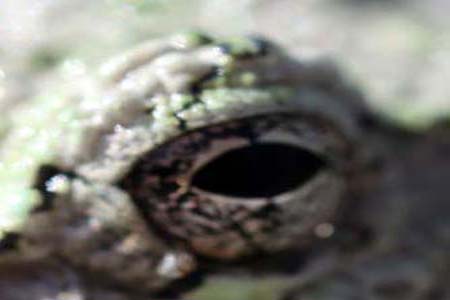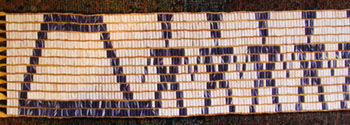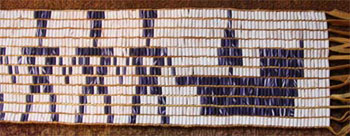 |
 |
 |
Wampum Belt Archive
Annual Presents - 24 Nations Treaty 1764


Reproduction
Close-up left side |
Close-up right side |
Original Size: |
Length: 590 beads. Width: 12. Total: 7.080 |
Reproduction: |
Beaded Length: 101.5 inches: Width: 5.6 inches. Length with fringe: 124.5 inches. |
Beads: |
Beaded Length: 590 Rows by 12 Beads Wide; Total: 7,080 |
Materials: |
Warp: Leather. Weave: Artificial Sinew. |
Description (from Canadian. Org):
The Niagara Treaty created a new Covenant Chain [Fort Niagara Treaty 1764]between Britain and the Aboriginal nations of the western Great Lakes, including the Iroquois Confederacy, the Algonquin and the Huron nations. Britain had been at war with some of these nations since 1760.
The British were represented by Sir William Johnson, who reaffirmed the historic relations between the two groups and offered solutions to problems between them. This treaty grew out of the Royal Proclamation of 1763, which proposed fair and voluntary land dealings between the British and Aboriginals.
The Niagara Congress met in July 1764 and it included members from 24 Aboriginal nations and Crown officials. More than 2,000 people attended.
Promises made by Johnson during this congress were preserved on wampum belts that were woven with hundreds of colored shell beads. These belts made up the Twenty Four Nations Belt that recorded the event.
The Annual Presents Belt shows twenty-four figures (representing the Aboriginal nations) holding hands between a ship (Britain) and a rock (North America). To the Aboriginals, the promise spoken to them was that the King would always give gifts each year to the 24 nations on the belt. If the British forgot this promise, the Aboriginals would link together to pull the 'ship' from Britain.
Johnson promised these presents for "as long as the sun shone and the grass grew, and the British wore red coats." These promises would, however, be gradually discontinued in Upper Canada starting in 1836.
These promises were recited every year for nearly a century during annual gift-giving ceremonies. The Aboriginals placed importance in the material goods given to them - blankets, pipes, pelts and various tools of much better quality than could be obtained through fur traders. However, they place as much importance on the symbolism of sharing and respect between the British and Aboriginal nations that took place during these ceremonies.
During the War of 1812, Aboriginals involved with this treaty would fight with the British, as they believed the treaty bound them to the British cause.
This belt, along with the Niagara Treaty belt (1764) have been reported lost in a fire at the turn of the 20th century.
See the Fort Niagara Treaty (1764) Belt for additional information.
Drawing of the Twenty-Four Nations Belt was done by Rev. George Hallen. The belt was loaned to him by the Ottawa Chief Assekiknik (Blackbird), from Michilimackinac, in 1852 (Hunter, 1901).
Notes on the drawing described the belt as being 590 rows long by 12 rows wide, giving the total number of beads to be 7,080. Written in the margins was "24 Nations" and the name Nishkawzhiniee. To the left of this name is noted "his father" referring to Assekikuk's father. On the right side of the drawing is noted "the belt of 1764 was given to him." Beneath this name is inscribed the name Nasomushkooda, with the remarks, "lives in the States. Below this name is the name of Mookoomaunish "at Weikwamikong."
Hunter (1901) further wrote that Mrs. Jameson (Traveis, 1837, vol. 3, p. 273) spells the latter name Mocomaunish which means Bad Knife. Hallen presumes the three names are chiefs which the belt has passed hands between 1764 and 1852; starting with the gift of the belt by Sir William Johnson at Fort Niagara pow-wow in 1764.
A similar belt pattern was in the possession of a chief of the Oka Nation at Two Mountains, near Montreal. And the meaning of the belt was the same that annual presents were to be given in exchange for their lands (Hunter, 1901; p.54).
The Ontario Archaeological Report of 1901 described this belt:
Figure 26. It consists of 12 strings, each containing 590 beads, or a total of 7,080 beads. The words "24 Nations" are written in two places on the margins, and they evidently explain the meaning of the 24 human figures on the belt. Mr. Hallen further notes on the margin the name of Nishkawzhininee. At the left of this name are the words,"his father," probably meaning Assekiknk's father. At the right of the name it is stated "the belt of ~704 T, as given to him," evidently referring to this belt. Beneath the above Indian's name is that of Nawsomushkooda. with the remark "lives in the States." And beneath that again is the name of Mookoomaunish,"at Weikwamikong." Mrs. Jameson (Travels, 1837, Vol. 3, page 273) spells the latter name Mocomaunish (the Bad Knife).
The three names are perhaps those of the chiefs through -whose hands the belt passed from 1764 till 1852. In all probability this belt was one given by Sir Wm. Johnson at the famous "Niagara pow-wow in 1764. The pattern shown on this belt, viz., human figures clasping each other by the hand and holding onto a ship at one 3nd of the chain and a wigwam at the other, does not seem to have L-jen uncommon on wampum belts. The old Chief of the Oka Indians at Two Mountains, near Montreal, had a belt of similar pattern. It was commemorative of their treaty with the British, as the figure of the ship would lead one to suppose. The import of the Oka belt, as described to the writer by an aged Indian who had seen it and heard it explained, was that the British were bound to supply the Indians with annual presents from the ship. If they should fail, the Indians would be at liberty to act unitedly to secure their just rights. The annual presents were to be given in return for the lands the white men took from the Indians. Such .vas the meaning of the Oka belt, and such is probably the meaning, or nearly so, of the belt of the Ottawas shown here. It is a very free translation of the pictographs, but comes near the meaning. Mr. Hallen penciled on the margin of this belt the following particulars as to die ends of the belt: "Size of leathern strings, about one-tenth of an inch in breadth, varying from 4 to 14 inches in length. They hang out at each end of the wampum belt."
References:
Canada In The Making: http://www1.canadiana.org/citm/themes/aboriginals/aboriginals4_e.html#niagara
Hunter, A. F. 1901. Wampum Records of the Ottawas. In Annual Archaeological Report 1901, Provincial Museum and Art Gallery of Ontario, Ontario Archaeological Museum, Toronto, CA., pp.52-55.
 |
 |
 |
 |
 |
 |
 |
 |
|---|

